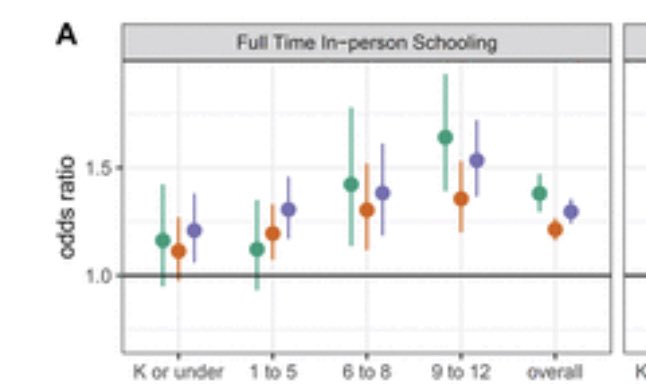
1/ New #COVID19 #K12 paper in @ScienceMagazine: the part that most excites me is zooming in on the safety measures that best predict low #COVID19 risks...
science.sciencemag.org/content/early/…
science.sciencemag.org/content/early/…
https://twitter.com/JustinLessler/status/1387842131629207552
2/ Parents & school staff & community members really want to know: What is most important? What measures should be prioritized at my school? This paper models that in detail: results reinforce findings from previous work
https://twitter.com/JustinLessler/status/1387842126692507650
3/ importance of extracurriculars consistent with a lot of what’s seen in contact tracing of #K12 outbreaks - it’s usually not the classroom contact; it’s the less regulated extracurricular time.
4/ importance of teacher masking also fits the literature: in many different kinds of studies, adults are riskiest for transmission
5/ Daily symptom checks is also a really interesting one. Bc kids’ symptoms can be non-specific, wasn’t clear how valuable this is. This is really strong evidence that the daily symptom checks (my family do paper form at daycare, apps for K) matter...
6/ There could be all kinds of mechanisms at play here (including proxy for district commitment to safety practices and access to expert advice), but it seems worth keeping around.
🧵7/ Bc #COVID19 K12 policies and safety measures are very much *not* distributed randomly (unfortunately, this has gotten really tangled up w politics & social signaling), the team does lots of fun sensitivity analyses...
https://twitter.com/JustinLessler/status/1387842141146140674
🧵 8/ I don’t have time to go into it but the sensitivity analyses themselves give interesting insights about mechanisms (parental behavior, community behavior)
9/ But maps from the paper are a great display about how geographically patterned #K12 in-person schooling & mitigation were: in the bizarro-world way that defines a lot of local #COVID19 policy, places that were more “open” also more likely to use fewer safety measures 

🧵10/ Some caveats/context: Data were from the first part of winter surge (late Nov-late Dec 2020) and early 2021 (Jan, early Feb), before large-scale vaccination of school staff and parents of children.
11/ results might differ in this half-vaxxed era in US. My guess: a much wider spread in family risk from K12, with practically 0 risk in some communities but maybe higher risk in places with lots of community & teacher resistance to vaccination + relaxation of safety measures
🧵 12/ second big caveat: all data were from one-time (cross-sectional) Facebook surveys. Pros and cons that the authors discuss. They try to control for non-representative nature of sample using internal Facebook data and other demographic info. It’s reasonable
🧵13/ 1 other observation not particular to this paper: covariate control for variables like percent Black and percent poor in a county. An exciting area of innovative in #EpiTwitter methods is interrogating assumptions behind these controls in light of structural inequalities
🧵14/ Another finding hat’s consistent w previous research is lower risk from younger kids than older #K12 students
* note: Anyone who lumps all preschool & K12 into one bucket is not being evidence-based. Extra side-eye if they also lump in university students 😒
* note: Anyone who lumps all preschool & K12 into one bucket is not being evidence-based. Extra side-eye if they also lump in university students 😒

🧵 15/ Really good point in comments: structural safety measures like improving ventilation were not assessed in these data. Bc data were from Facebook survey mostly capturing parents, focus was on visible behavioral measures
https://twitter.com/collblick/status/1388110855200464896
• • •
Missing some Tweet in this thread? You can try to
force a refresh



